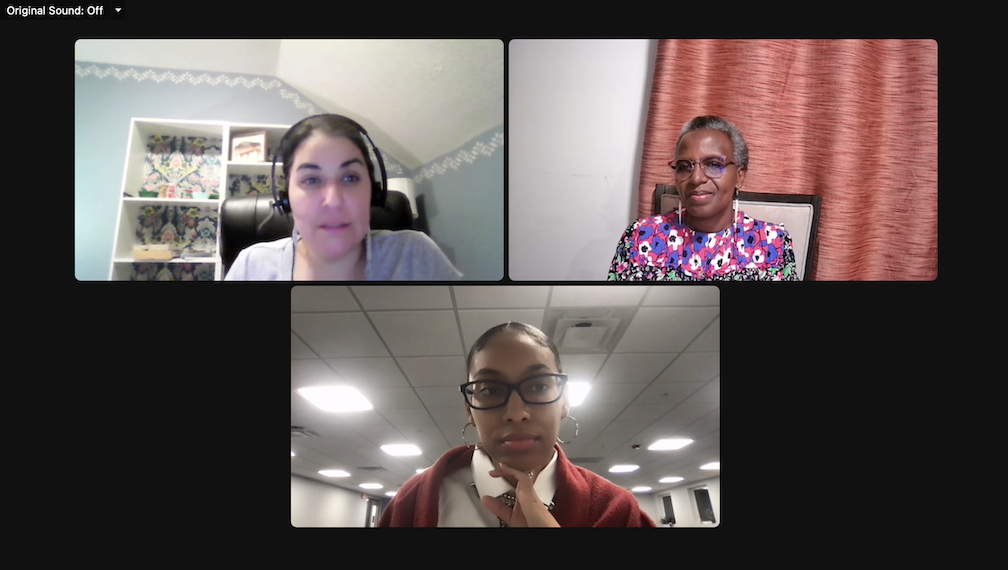Leaders from BIPOC-Led Nonprofits speak on their experiences
February 18, 2022
 Andrew Cohen
Andrew CohenThe Common Good Grant Committee (CGGC), part of the McKeen Center for the Common Good, hosted a BIPOC-Led Nonprofits in Maine panel on Wednesday. Common Good Grant Student Directors Elise Hocking ’22 and Jessica Bae ’22 moderated the panel.
The panelists were Co-Founder and Executive Director of educational nonprofit In Her Presence Claudette Ndayininahaze, Heather Augustine of indigenous advocacy and education group Wabanaki REACH, Co-Founder of indigenous-focused hunger nonprofit Eastern Woodlands Rematriation Collective Alivia Moore and Deputy Director of the creative nonprofit Indigo Arts Alliance Jordia Benjamin.
CGGC member Ryan Ngo ’25 noted that this event was part of a new initiative the committee started this year.
“The CGGC separates nonprofits into specific buckets—specific umbrella categories so that we can have a well-rounded profile of [nonprofit donations],” Ngo said. “Things like environmental activism, housing security, etc. This year we made a specific umbrella group, a specific bucket dedicated to BIPOC-led nonprofits and at least one indigenous Wabanaki organization that we’re going to fund. So we have a very newfound commitment this year. I’m excited.”
After giving brief introductions about themselves and their organizations, the panelists were asked to discuss their experiences working in a BIPOC-led nonprofit as well as any barriers they have faced due to their location in Maine, a predominantly white area. Ndayininahaze and Augustine both emphasized the difficulty in obtaining funding.
“If you look at grant funding, it will say, ‘we’re allocating this amount of money for BIPOC organizations.’ But really, if you think about that, it really pits us against one another in a lot of ways. It makes us compete over small funding dollars. And so instead of helping one another thrive and elevating our work in communities … it really creates a division between us, or at least it’s supposed to,” Augustine said. “All this [DEI] momentum—it seems like it’s sometimes putting resources in the wrong places. Put some of those funding dollars towards these organizations instead of training those white-led organizations in how to include us in their organizations.”
The next question for the panelists was about what they found surprising about how their organization’s identity as being BIPOC-led shapes their work environment and organization as a whole. Benjamin noted that her experiences have been more confirming rather than surprising.
“We are again a black-led organization that focuses on artists of the African diaspora. Particularly communities that have had experience [with] colonization or descendants of the transatlantic slave trade, and because our community and work is focused on a section of community that is often overlooked and disregarded within art history, within the arts, within the historical canon, we have a system in place that is a mentoring system through our residency program,” Benjamin said.
The Indigo Arts Alliance mentoring program pairs a BIPOC artist in residency at the Alliance with a New England-based BIPOC artist. They are put in residence together with the goal to form a long-lasting relationship that grows outside their time together in the studio. Benjamin mentioned that the organization views mentorship as essential to creative development and growth.
The panelists then discussed how they have dealt with frustrations and challenges they have encountered as BIPOC leaders in the predominantly white nonprofit sector. Moore emphasized that she is indigenous and does not identify as a person of color. That said, she still gave insight into her experiences.
“I’m responding to this question not as a person of color but as an indigenous person—as Penobscot surrounded by white settler folk,” Moore said. “When I’m invited to speak or be in community with white organizations, ones where I feel like I’m going to be able to actually say what I see going on, what I think needs to be said to serve my community. I have no time, energy or patience for being in spaces where I can’t say what I feel like needs to be said, or I feel like I need to ‘play nice.’
Ndayininahaze used the discussion as a jumping-off point to highlight the importance of having conversations between people of different backgrounds.
“[Students] should really remain open-minded and see and understand that there are systemic inequities,” Ndayininahaze said. “They really need to be in connection and in relationship with different communities … so they can understand what is really inside. So they need to promote those conversations with nonprofits so they can raise the understanding and awareness of those inequities.”
Rose Keller contributed to this report.

Comments
Before submitting a comment, please review our comment policy. Some key points from the policy: